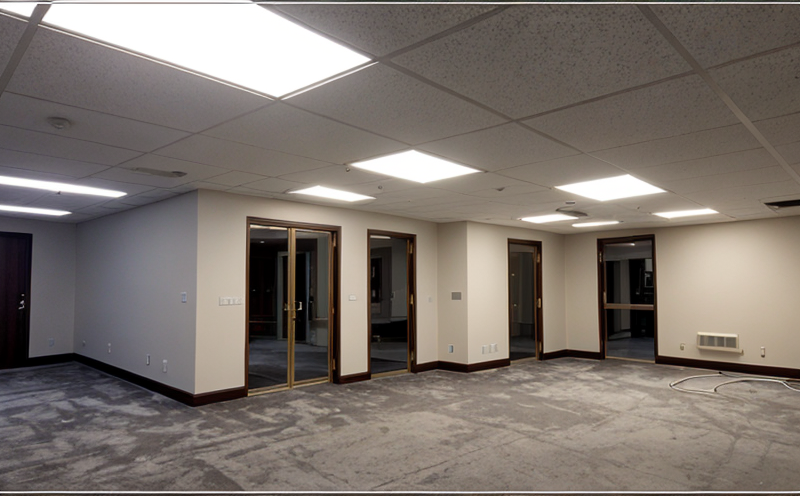CIE 169 Practical Photometric Testing of Architectural LED Systems
The CIE 169 standard provides a practical photometric testing procedure for architectural LED systems. This standard is crucial in the lighting industry as it ensures consistent and reliable measurement of light output, color rendering index (CRI), luminous flux, and other important parameters that are critical to the design and performance of architectural LED fixtures.
The test procedure outlined in CIE 169 involves several steps, starting with the preparation of the specimen. The specimen must be placed in a darkroom environment for at least one hour prior to testing to ensure accurate measurement of light output. Once prepared, the specimen is placed on an integrating sphere equipped with a spectroradiometer to measure its light distribution and color characteristics.
The test parameters are carefully chosen based on the intended use of the architectural LED system. For instance, downlights require different lighting distributions compared to recessed or linear fixtures. The CIE 169 standard allows for flexibility in testing these variables by specifying a series of test points around the luminaire. This ensures that all critical areas of the fixture are tested and reported accurately.
Once the data is collected, it is analyzed using statistical methods to ensure consistency across multiple specimens. The standard also includes acceptance criteria which specify the permissible limits for various parameters such as CRI, color temperature, and luminous flux. These criteria help manufacturers meet market expectations and regulatory requirements.
The photometric testing procedure outlined in CIE 169 is not only important for ensuring product quality but also for compliance with international standards such as IEC 62471-3 and EN 62471-3. These standards address the safety aspects of LED lighting, particularly concerning blue-light hazard (BLH). The CIE 169 standard complements these by focusing on the optical performance.
Architectural LED systems are designed to enhance both functionality and aesthetics in interior and exterior spaces. The choice of color temperature, light distribution, and color rendering index can significantly impact the ambiance of a space. Accurate photometric testing ensures that these factors are optimized for each application, whether it's residential, commercial, or public.
Understanding the technical parameters involved is essential for quality managers, compliance officers, R&D engineers, and procurement professionals who work in this sector. By adhering to CIE 169 standards, manufacturers can ensure that their products meet the highest quality and reliability standards, leading to satisfied customers and a positive market reputation.
Industry Applications
| Application | Description |
|---|---|
| Downlights | Testing for uniform light distribution in high-ceiling spaces to enhance visual comfort and energy efficiency. |
| Recessed Fixtures | Evaluating the light output and color rendering performance of fixtures installed within ceilings or walls. |
| Linear Fixtures | Assessing the lighting characteristics of long, continuous fixtures used for task lighting in offices and retail spaces. |
| Exterior Lighting | Ensuring that architectural LED systems meet specific outdoor requirements such as color temperature and CRI for aesthetic and safety reasons. |
| Museum Displays | Optimizing the lighting conditions to prevent damage to artifacts while enhancing visibility and appreciation of exhibits. |
The applications listed above demonstrate the versatility of CIE 169 in addressing the diverse needs of the architectural LED industry. By providing a standardized testing procedure, this standard ensures that all stakeholders can rely on consistent results when evaluating the performance of architectural LED systems.
Why Choose This Test
- CIE 169 provides a practical and flexible approach to photometric testing tailored specifically for architectural LED systems.
- The standard ensures that all critical parameters such as CRI, color temperature, and luminous flux are accurately measured and reported.
- It supports compliance with international safety standards like IEC 62471-3 and EN 62471-3 by addressing optical performance.
- The procedure allows for testing under various conditions to ensure consistent results across different specimens.
- CIE 169 ensures that architectural LED systems meet the highest quality and reliability standards, leading to satisfied customers and a positive market reputation.
- It provides flexibility in testing parameters such as light distribution and color characteristics based on intended use.
- The standard is widely recognized and accepted by industry professionals, ensuring consistent results globally.
The benefits of using the CIE 169 standard are clear: it ensures accurate, reliable, and consistent photometric testing that meets both technical and market demands. This makes it an essential tool for quality managers, compliance officers, R&D engineers, and procurement professionals in the architectural LED sector.
Quality and Reliability Assurance
The CIE 169 standard plays a crucial role in ensuring the quality and reliability of architectural LED systems. By providing a standardized testing procedure, it helps manufacturers meet market expectations and regulatory requirements. The following are some key aspects of how this standard contributes to quality assurance:
- Consistency Across Specimens: The statistical methods used in CIE 169 ensure that the results from different specimens are consistent, allowing for accurate comparisons.
- Compliance with International Standards: By adhering to CIE 169 and other relevant standards like IEC 62471-3 and EN 62471-3, manufacturers ensure that their products meet safety and performance criteria globally.
- Precision in Measurement: The use of integrating spheres and spectroradiometers ensures precise measurement of light output, color rendering index, and other critical parameters.
- Flexibility in Testing: CIE 169 allows for testing under various conditions to ensure that all critical areas of the fixture are evaluated accurately.
- Customer Satisfaction: By ensuring high-quality products, manufacturers can meet customer expectations and build a positive market reputation.
- Market Leadership: Compliance with CIE 169 standards positions manufacturers as leaders in quality and reliability within the architectural LED industry.
In conclusion, the CIE 169 standard is an essential tool for ensuring the quality and reliability of architectural LED systems. Its standardized approach to photometric testing ensures that products meet both technical and market demands, leading to satisfied customers and a positive reputation in the industry.





